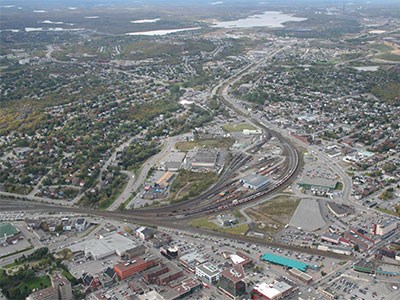If you were a youth in Sudbury, chances are you, or someone you know, spent a summer or two lugging bags of dolomite limestone up the city’s barren hills, prepping the ground for reforestation.
The routine is so ubiquitous, it’s almost become a rite of passage, said Dr. Peter Beckett, a reclamation, restoration and wetland ecologist with Laurentian University who’s dedicated his life’s work to rejuvenating the city’s landscape.
“I’m beginning to think that, by the time we finish this program, everybody in Sudbury will have done this,” Beckett chuckled during his keynote address at a recent meeting of the Canadian Institute of Mining, Metallurgy and Petroleum. “It’s part of growing up in Sudbury, to put lime bags down on the hills.”
Over four decades, the city has spent $28 million planting 9.5 million trees, and life has returned to Sudbury, once pegged as a barren moonscape.
Yet despite the decades-long investment, the work is only half done: 3,450 hectares have been reclaimed, but 7,000 altogether need to be done.
That’s still a fraction of the 81,000 hectares impacted by industrial activity, which began with logging in the late 1800s and intensified with the onset of mining when open roasting beds sent high levels of sulphur dioxide into the air, raining down metal particulate, which leached into the soil, impacting the ecosystem.
Recognizing the need for rejuvenation, the city formed VETAC (the Vegetation Enhancement Technical Advisory Committee) in 1973. The volunteer committee, of which Beckett is a founding member, brought together science, industry, academia, government and Sudbury’s citizenry to brainstorm ideas on how to return the land to its original state.
What transpired has become a model for other industrial areas around the world, and Sudbury’s reforestation program has earned numerous accolades, including the prestigious United Nations Local Government Honors Award.
The committee started reforestation with coniferous species — pine and spruce — and has expanded its repertoire to incorporate more than 40 species, including deciduous and fruit-bearing varieties. A glimpse into Sudbury’s original landscape can be taken in the area of Wolf Lake where some old-growth red and white pines are 200 to 250 years old.
“This is what the whole of Sudbury was like 150 or so years ago,” Beckett said.
Moss, mammals and birds are now returning, and lichens are reappearing at the same rate in Sudbury as they would in an area outside of Sudbury that had been impacted by fire.
“If we look and compare the air quality in Sudbury now, we actually have some of the cleanest air in the whole province, particularly in the summer,” Beckett said. “Most people won’t believe you if you tell them we live in a city with clean air.”
In a new series of experiments, VETAC is teaming up with local farmers to plant biomass crops on tailings ponds. Waste from paper mills, municipal construction and compost are spread on tailings at various thicknesses, and then plots of canola, switchgrass, sunflowers and willow are planted over top.
“If we can stop the oxygen from going through the organic, because it gets absorbed by all the bacteria in the organic layer, then we won’t have such a problem with oxidation and acid generation,” Beckett explained. “The thicker the organic layer, the better it actually is.”
The resulting crops, which grow rapidly, can then be harvested, formed into pellets and shipped to southern Ontario for use as biofuel.
“What could be greater than taking all those tailings in Northern Ontario, growing things like switchgrass or willows and then being able to send it into pellets to make electricity?” Beckett said.




